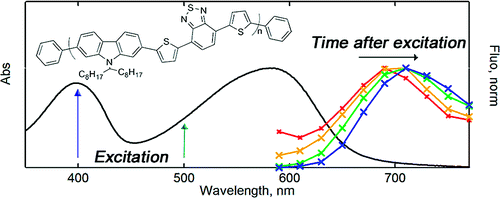-
Ultrafast spectroscopic investigation of a fullerene poly(3-hexylthiophene) dyad
N. Banerji, J. Seifter, M. Wang, E. Vauthey, F. Wudl and A.J. Heeger
Physical Review B, 84 (2011), p75206-75206


DOI:10.1103/PhysRevB.84.075206 | unige:16782 | Abstract | Article PDF

We present the femtosecond spectroscopic investigation of a covalently linked dyad, PCB-P3HT, formed by a segment of the conjugated polymer P3HT (regioregular poly(3-hexylthiophene)) that is end capped with the fullerene derivative PCB ([6,6]-phenyl-C61-butyric acid ester), adapted from PCBM. The fluorescence of the P3HT segment in tetrahydrofuran (THF) solution is reduced by 64% in the dyad compared to a control compound without attached fullerene (P3HT-OH). Fluorescence upconversion measurements reveal that the partial fluorescence quenching of PCB-P3HT in THF is multiphasic and occurs on an average time scale of 100 ps, in parallel to excited-state relaxation processes. Judging from ultrafast transient absorption experiments, the origin of the quenching is excitation energy transfer from the P3HT donor to the PCB acceptor. Due to the much higher solubility of P3HT compared to PCB in THF, the PCB-P3HT dyad molecules self-assemble into micelles. When pure C60 is added to the solution, it is incorporated into the fullerene-rich center of the micelles. This dramatically increases the solubility of C60 but does not lead to significant additional quenching of the P3HT fluorescence by the C60 contained in the micelles. In PCB-P3HT thin films drop-cast from THF, the micelle structure is conserved. In contrast to solution, quantitative and ultrafast (<150 fs) charge separation occurs in the solid-state films and leads to the formation of long-lived mobile charge carriers with characteristic transient absorption signatures similar to those that have been observed in P3HT:PCBM bulk heterojunction blends. While π -stacking interactions between neighboring P3HT chains are weak in the micelles, they are strong in thin films drop-cast from ortho-dichlorobenzene. Here, PCB-P3HT self-assembles into a network of long fibers, clearly seen in atomic force microscopy images. Ultrafast charge separation occurs also for the fibrous morphology, but the transient absorption experiments show fast loss of part of the charge carriers due to intensity-induced recombination and annihilation processes and monomolecular interfacial trap-mediated or geminate recombination. The yield of the long-lived charge carriers in the highly organized fibers is however comparable to that obtained with annealed P3HT:PCBM blends. PCB-P3HT can therefore be considered as an active material in organic photovoltaic devices.

